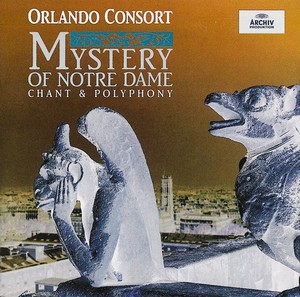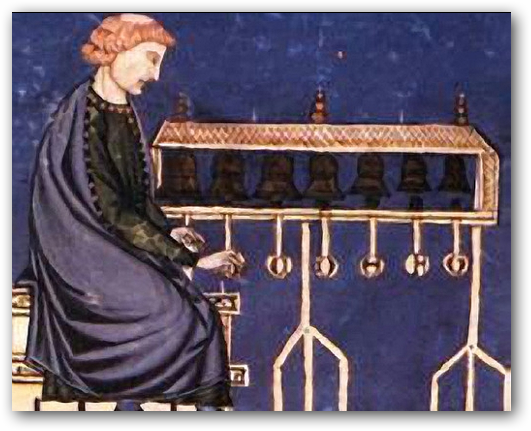This week’s theme is…Pin the Tail on the Donkey! Like many music lovers I boast an extensive and comprehensive record collection. For this week, I closed my eyes and selected 5 different albums. Here’s what I picked…

Pin the Tail on the Donkey, Day 3 – Sederunt Principes by Perotin

A few years ago I met a great musician who became both a friend and collaborator. He is a tremendous organist and choral conductor. During the time that I knew him the best he was the music director for one of the Catholic churches in my town. He extended to me the opportunity to compose a polyphonic piece for his choir based on Gregorian Chant. The premiere was scheduled to coincide with a workshop about Gregorian Chant performance from which I gained a great deal of knowledge about and appreciation for the practice of the noble artform. These events flowed from the liturgically conservative sensibility which, at the time, prevailed at that particular church. This is to say that many members of the congregation there favored an approach to liturgy which contained features more common before the Second Vatican Council of the 1960s.
Among other implications, the documents of Vatican II seemed to indicate that the austere and florid liturgical style, which had been in use since at least the time of the Protestant Reformation, could be somewhat softened and deformalized. On a practical level this meant dispensing with Latin in favor of the vernacular and largely discarding the elaborate and primarily priestly sequence of the older Mass liturgies in favor of a more direct version of the ceremony which facilitated congregational interaction. As a result of the reforms of the Second Vatican Council there are many people, Catholics included, alive today who have little or no experience with the liturgical style that was replaced. Named for the 2 decades-long Council of Trent, the most focused expression of the Church’s counter reform efforts, the Tridentine liturgy codified the words, choreography and musical styles appropriate for the Mass for the next half millennium. The elements which populated the Tridentine mass are most certainly older than this, but never had they been so rigorously defined or formally organized. While it underwent reforms as a result of Trent, the general character and application of Gregorian Chant remained unchanged and would serve to provide the aesthetic character of Roman Catholic worship for centuries to come, almost until our present day.
Some Catholics not entirely convinced that the reforms and spirit of the Second Vatican Council have been entirely beneficial. In addition to the numbers which indicate alarming declines in priests and religious, and what many perceive to be the the Church’s weakened moral authority in the world, some mourn the loss of the Tridentine liturgy, in their estimation perhaps the most beautiful and sacred experience possible to behold this side of the veil. If you have never attended one you can at any of a small handful of Catholic churches which have revived the practice, but thanks to the magic of the internet you can also view one from the comfort of your own home!
From even just a few moments of the Tridentine liturgy it is revealed clearly as a detailed world full of countless physical and verbal strokes, exquisitely measured and deliberate in their execution. It is this quality to which its devotees point as a bastion of sacred tranquility in a world of profanity and chaos. And I would argue that it is largely the soundtrack of the Latin Mass, timeless, expansive Gregorian Chant, and its cultural progeny which provided a fertile soil in which the other gestures and ornaments were able to take root. One of the unfortunate effects of the Second Vatican Council is that today Gregorian Chant is largely relegated to the classrooms of music history studies, removed from the living tradition and practice which shaped it and kept it alive for so many centuries.
The fact is that anyone who enjoys and derives nourishment from the music of the Western canon owes Gregorian Chant a mighty debt of gratitude. When historians trace classical music back to its origins, it often ends up there, and the story of the first stylistic departure from Gregorian Chant is fascinating, even amazing at times. While Gregorian Chant has remained in use since its codification more than a millennium ago, it has also served as the basis for technical and expressive experiments that have served to advance Western music into new stylistic territories.
Gregorian chant is monophonic, which means that at any given time there is one, unaccompanied musical line. Most of the music we listen to is not monophonic, and Gregorian Chant is extraordinary for the expressive unity found across its entire, massive body of single-line compositions. But musicians, being creative people, were not satisfied with the status quo and the elaboration of texture was one of their first areas of development. Soon, in a manner of chant called organum, church musicians added more lines to the originally monophonic Gregorian melodies. It began simply, with one additional voice that closely followed the rhythm of the original chant:
But steadily it became more complicated and intricate, culminating in the 1100s when a group of musicians working at the famous Cathedral of Notre Dame in Paris brought organum to its highest level of development. Notre Dame Organum, as the body of work has come to be called, is the product of two composers, shrouded in mystery by the veil of the past, Leonin and Perotin. Together they created a collection of intriguing, mesmerizing works which planted the seeds of all subsequent polyphonic music Europe. Someone had the idea to take small fragments of Gregorian Chant and extend the individual notes as drones which could form the basis of florid improvisations. One singer would hold the notes of the original chant (this voice was called the tenor, from the Latin tenere “to hold”) and other singers would sing busy, active lines above it. Leonin, the earlier composer of the two, composed single lines above the tenor, sounding like this:
His successor Perotin added more voices to his compositions, creating the first three and four-voice compositions in the history of Western music. Here is one of his only remaining four-voice works, Sederunt Principes, based on Psalm 119 (the Hebrew acrostic), for the feast day of St. Stephen, the first martyr of Christian Legend. In Sederunt Principes we hear the expressive potential of Notre Dame Organum as the crisp sonorities implore listeners to turn to God’s mercy in the face of persecution:
| Latin | English |
| Sederunt principes, et adversum me loquebantur:
et iniqui persecunti sunt me. salvum me fac propter misericordiam tuam. |
The princes sat, and spoke against me:
they have persecuted me unjustly. Save me for thy mercy’s sake. |
The resplendent colors of Notre Dame Organum considerably enhanced the already solemn and ceremonial nature of Gregorian Chant to what must have been impressive and even stunning levels. Subsequent composers, beginning with Machaut, de Vitry (see this post) and later Josquin de Prez (see this post), Orlando di Lasso (see this post) continued to develop the polyphonic practice established by the composers of the Notre Dame School, a line of development which eventually culminated in Palestrina. To keep things in perspective, Palestrina lived approximately as long after Leonin as we do after him.
Certainly the Second Vatican Council has born fruits considered by many to be beneficial. It is hard to imagine the pontificate of John Paul II having had the tenor that it did without them. The complex moral and social effects are not something I wish to explore here, but I think it is safe to argue that relegation of the glories of such liturgical riches as Gregorian Chant and the Tridentine Mass to the classroom and museum may be counted among its drawbacks. Certainly it is difficult to extricate these matters from the moral and social ones, but as a result of the Second Vatican Council it is not really possible to experience Gregorian Chant or Renaissance Polyphony in their natural habitats as it was prior to the 1960s. Some are also quick to point out that the Council did not technically change the nature of music in the Catholic Church: the documents of the council do specifically state that Gregorian Chant should be given “pride of place” over other styles due to its “special suitability to the Roman liturgy”. Some might argue that the general ecumenical spirit unleashed by this council justifies the use of radically different styles of music, but the presence of that language certainly allows more conservative liturgists (and popes, like emeritus Benedict for example) to make their case. Of course we all need to adopt the proverbial “Catholic view of time” to see how this all plays out.
—
Would you like Aaron of Smart and Soulful Music to provide customized program notes especially for your next performance? Super! Just click here to get started.
Want to listen to the entire playlist for this week and other weeks? Check out the Smart and Soulful YouTube Channel for weekly playlists!
Do you have feedback for me? I’d love to hear it! E-mail me at smartandsoulful@gmail.com
Do you have a comment to add to the discussion? Please leave one below and share your voice!
Subscribe to Smart and Soulful on Facebook and Twitter so you never miss a post!